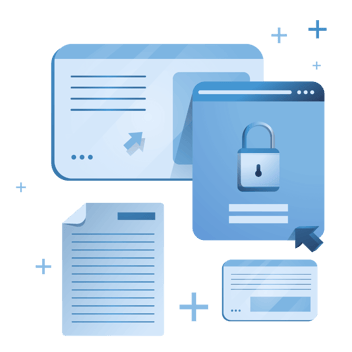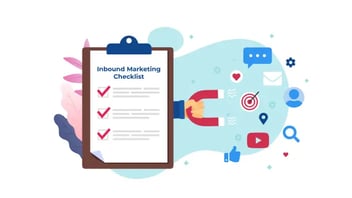Inbound Lead Generation: Turning Visitors into Customers
One of the main goals of inbound marketing is to generate leads – potential customers who have shown an interest in your product or service. But inbound lead generation itself is not enough. To truly benefit from inbound marketing, you must convert those leads into paying customers.

Inbound marketing is a strategy that focuses on attracting, engaging, and delighting customers through relevant and valuable content. It's a way of earning the attention and trust of potential customers rather than using traditional forms of advertising to interrupt them. And it is one of the lead generation approaches with the highest Return on investment (ROI).
Why Does Inbound Lead Generation Matter?
-
80% of marketers say lead nurturing is essential for converting leads into customers. Lead nurturing is a critical component of any inbound marketing strategy.
-
Companies that nurture leads see a 25% increase in close rates. Nurturing leads is crucial to increase the likelihood of converting them into paying customers.
-
The average lead nurturing campaign takes 12 weeks. While lead nurturing may take months, the results are worth the investment for companies looking to increase their chances of converting leads into paying customers.
-
The most effective lead nurturing tactics include email, social media, and content marketing. These tactics will ensure potential customers stay informed and engaged with your business offerings and services.
-
The best way to measure the success of your lead nurturing campaign is to track the number of leads that convert into customers. Analyzing the number of leads that convert into customers will allow you to gauge the effectiveness of your tactics and make necessary adjustments to your campaign.
By leveraging these trends, businesses can develop effective lead-nurturing strategies and convert more leads into customers.
So, how do you do that? Here are some tips for converting inbound marketing leads into customers:
Nurture leads with targeted content.
Nurturing leads with targeted content is crucial to successful inbound marketing strategies.
-
Define the buyer's journey. The first step to nurturing leads with targeted content is identifying the buyer's journey for your target audience. This means understanding who they are, their interest, their pain points, and how they make decisions. You can do this by conducting market research, surveying your current customers, and analyzing your website traffic.
-
Create valuable content. Once you understand your target audience, you can create valuable content that speaks directly to their needs and interests. This content can include blog posts, infographics, e-books, case studies, and webinars. The key is to create relevant, informative, and engaging content.
-
Distribute your content. Once you have created valuable content, you must distribute it to your target audience. Email marketing campaigns are an effective way to nurture leads with targeted content. By segmenting your email list based on the interests and behaviors of your leads, you can send targeted campaigns that are highly relevant to their needs and interests in the specific state of the buyer's journey. You can also use automation tools to trigger emails based on specific actions your subscribers took, such as downloading a whitepaper or visiting a particular page on your website.
Another way to nurture leads with targeted content is through social media campaigns. You can engage with your target audience and build relationships with potential customers by posting relevant and valuable content on social media platforms. You can also use social media advertising to target specific demographics and interests, allowing you to reach a highly targeted audience with your content. -
Track your results. It's essential to track the results of your lead nurturing campaigns to see what is working and what is not. You can track metrics like open, click-through, and conversion rates. This information will help you to improve your campaigns over time.
In addition to email marketing and social media, other channels to nurture leads with targeted content include your website, blog, other online platforms, and offline channels such as trade shows, events, and print materials.
Example: If you were to sell software for small businesses, you could:
-
-
-
Create a blog post about the top challenges facing small businesses. This post would be relevant to your target audience and help you build relationships with potential customers.
-
Create infographics about the benefits of using your software; they are visually appealing and help you share your message with a broader audience.
-
Host a webinar about how to use your software. This webinar would be a great way to educate potential customers about your product and answer their questions.
-
-
Use lead magnets to capture email addresses.
Lead magnets are a powerful tool for capturing email addresses and growing your list. A lead magnet is a free resource or offer that is highly valuable to your target audience and is exchanged for their email address. By offering a lead magnet, you can entice potential subscribers to give you their email addresses, allowing you to nurture them with targeted content and eventually turn them into paying customers.
You can use many types of lead magnets to capture email addresses, and the best one for your business will depend on your target audience and the products or services you offer. Some examples of lead magnets include:
-
Ebooks and whitepapers: These are in-depth resources that provide valuable information on a specific topic. They are often longer than blog posts and are more comprehensive.
-
Checklists and templates: These practical resources help your target audience accomplish a specific task or goal. They are often easy to consume and provide immediate value.
-
Courses and webinars: These are more in-depth learning experiences that can be delivered online. They can be a great way to showcase your expertise and provide value to your target audience.
-
Free trials and demos: These are a great way to allow your target audience to try your product or service before purchasing.
To effectively use lead magnets to capture email addresses, you must make them highly visible and easy to access. This means promoting them prominently on your website and social media channels and using calls to action to encourage visitors to sign up. You should also make it easy for visitors to opt-in to your email list by providing a clear and simple form for them to fill out.
Once you have captured the email addresses of your potential subscribers, it is essential to follow up with them and continue providing value through targeted email campaigns and other forms of communication. This will help you build relationships with your subscribers and turn them into paying customers.
Example of a lead magnet that you could use to capture email addresses:
Free Ebook: The Ultimate Guide to [Your Topic]
This ebook will teach you everything you need to know about [your topic]. You will discover the latest trends, best practices, and case studies. This ebook is the perfect resource for anyone who wants to learn more about [your topic].
To download your free ebook, simply enter your email address below:
[Email Sign-Up Form]
Use automation to streamline nurturing.
Lead nurturing is essential to any inbound marketing strategy, as it helps you build relationships with potential customers and guide them through the sales funnel. By providing valuable, relevant, and consistent content to your target audience, you can attract and retain a clearly defined group of customers and drive profitable customer action.
One way to streamline lead nurturing is through the use of automation. Using automation tools, you can trigger targeted emails, social media posts, and other communication forms based on your leads' actions. This allows you to deliver personalized and timely messages to your leads without manually sending each one individually.
Here are some ways you can use automation to streamline lead nurturing:
-
Set up automated email campaigns: By segmenting your email list based on the interests and behaviors of your leads, you can create targeted email campaigns that are highly relevant to their needs and interests. You can also use automation tools to trigger emails based on specific actions taken by your leads, such as downloading a whitepaper or visiting a particular page on your website.
-
Use social media automation: You can use automation tools to schedule social media posts in advance and trigger posts based on specific actions taken by your leads. This allows you to keep your social media channels active and engaging without constantly monitoring them.
-
Implement AI chatbots: Chatbots are automated chat programs that engage with your leads in real-time. They can answer frequently asked questions, provide personalized recommendations, and schedule appointments or demos.
-
Use marketing automation software: Marketing automation software is a powerful tool that automates various marketing tasks, such as email marketing, social media marketing, and lead management. You can streamline your lead nurturing efforts using marketing automation software and save time and resources when moving your prospects through the conversion funnel.
To effectively use automation to streamline lead nurturing, it is essential to define your lead nurturing goals and create a clear plan for using automation to achieve them. You should also carefully segment your leads and create targeted campaigns that speak directly to their needs and interests. And be sure to monitor and optimize your automation efforts to ensure they deliver the desired results.
Example: Using automation to nurture leads when selling software for small businesses. You could:
-
-
-
Set up an automated email campaign that sends emails to leads who download your ebook about small businesses' top challenges. The emails could include tips and advice on how to overcome these challenges, as well as links to other resources that might be helpful.
-
Use social media automation to schedule a series of posts on your company's social media pages that promote your ebook and offer tips and advice on the challenges facing small businesses.
-
You could implement a chatbot on your website that answers frequently asked questions about your software and provides personalized recommendations to leads.
-
-
Qualify leads before investing time and energy.
Lead qualification is essential in sales, as it helps determine which leads will become paying customers. By qualifying leads, you can prioritize your efforts and allocate your time and resources more effectively, resulting in a higher return on investment.
When qualifying leads, you can consider several factors; the specific criteria will depend on your business and target audience. Some common factors to consider include:
-
Budget: Does the lead have the budget to make a purchase? This is especially important if you offer high-priced products or services.
-
Authority: Does the lead have the authority to make a purchase decision? This may include decision-makers at a company, such as the CEO or CFO.
-
Need: Does the lead need your product or service? They may only be ready to purchase if they have a pressing need.
-
Timing: Is the lead ready to purchase now or in the near future? If they aren't prepared to make a purchase, it may not be worth investing time and resources in trying to close the deal.
To qualify leads effectively, you should use a combination of online and offline research and direct communication with the lead. For example, you can use social media and other online platforms to gather information about the lead's business and needs. You can also use email, phone, or in-person communication to ask questions and collect more data.
Example: Qualify leads when selling software for small businesses. You could:
-
-
-
Ask the lead about their company size, industry, and budget. You could also ask them about their current challenges and how they want to improve their business.
-
Use social media to research the lead's company. For example, you could look at the lead's company's website, social media pages, and employee profiles. This can give you a good understanding of the lead's business and needs.
-
Schedule a call with the lead to ask more questions and gather more information. This is an excellent opportunity to build rapport with the lead and learn more about their business.
-
-
By focusing inbound lead generation on customer conversion, you ensure that all the hard work in creating a content strategy, developing, optimizing, and earning a high SEO ranking is rewarded with actual revenue generation. This is crucial in turning your inbound marketing strategy into real profit and establishing yourself as a brand.






Leave a Comment